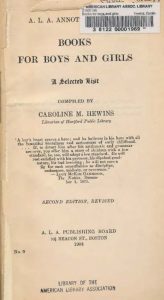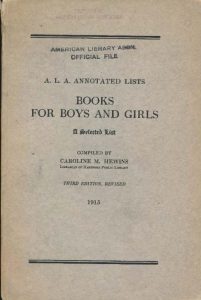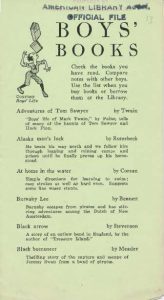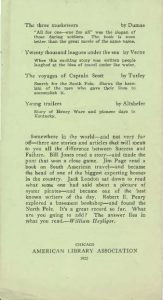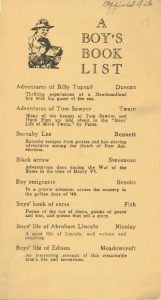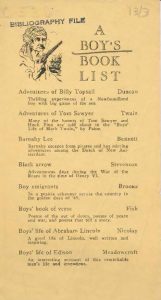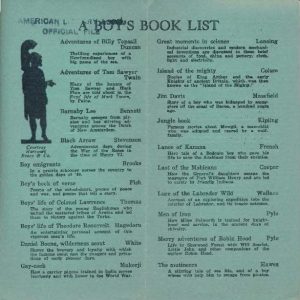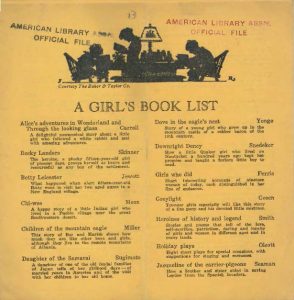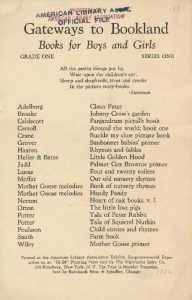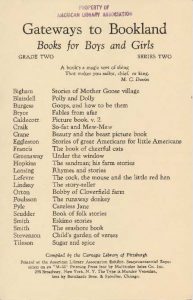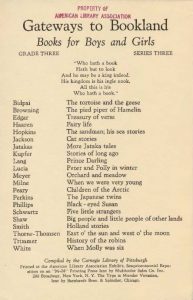As early as the 1920s through 1930s and known under a variety of titles, the American Library Association produced a series of resources to support popular young people’s reading in libraries. Each publication is rich in the experienced perspectives of library leaders of its time. Read on to learn more about early books for young people!
Before the production of many smaller pamphlets, the early A.L.A. Annotated Lists: Books for Boys and Girls: A Selected List, by Hartford Public librarian Caroline M. Hewins, guided librarians in identifying the right books for young people at the library. This publication was the ninth installment of the A.L.A. Annotated Lists series too. Published in multiple editions, Books for Boys and Girls includes a preface essay by the author (on the selection of books), the list of books (organized by subjects), and inspiring poems at the beginning of each topic. The book list is subdivided into sections including: “Illustrated Books for the Youngest Children”, “Magazines”, “Religion’, Life, Education, and Manners”, “Fairy Tales and Wonder Stories”, “Out-of-Door Books, and Stories of Animals”, “Applied Science”, “Amusements and Handicrafts”, “Painting and Sculpture”, “Music”, “Poetry Selections from Literature, and Stories Adapted from Great Authors”, “Stories of Home, School, City and Country Life and Adventure in the United States and England”, “Indians and Ranch Life”, “Voyages and Stories of Shipwreck and Desert Islands”, “Travel and Child-Life in Various Countries”, and “History and Historical Stories and Biographies”.
In 1922, Books for Vacation was published to aid with the selection of summer reading. In the issue above, the list is arranged by subjects including: “Adventures”, “Stories about Children”, “Stories from Other Countries or Cultures”, “Biographies of Famous Adults”, “Animal Stories”, “Poetry”, “Folklore and Mythology”, and “Picture Books about Children” too.
In 1922, Boys’ Books encourages young readers to friendly reading competitions among friends to finish the book list, and the book’s rear page includes an inspirational anecdote about famous men whose careers began with discoveries while reading books. In this list, books are arranged alphabetical by book title. Two years later, for the Rotary Club of New York and “with the advice of 700 libraries, teachers and business men throughout the country”, Myron T. Scudder, James Roe, and John Martin compiled their list of Books for Boys. This book list features titles arranged by suggested reader’s age and by author’s name thereunder.
In 1925, A Boy’s Book List was published with at least two variant cover images and A Girl’s Book List was published too. Both publications feature images inspired by books from the list, and books are arranged alphabetically by title.
At least as late as 1928, both titles continued to be published. In the two samples above, different color paper and layouts were employed to present the growing list of books for young readers.
Concurrently, some specialty publications were published for distribution at American Library Exhibits at International Expositions too. In the samples above, for the Sesquicentennial Exposition world’s fair at Philadelphia, Pennsylvania, the Gateways to Bookland series was published to include simple, cost effective lists to distribute to exhibit attendees. Over time, other titles would be created too, including the Science Booklist for Girls and Boys. From these humble first steps and for decades to come, the ALA’s support of young readers’ literacy would continue to develop and to grow with those readers and many more to come.
Copies Available at Your ALA Archives
Physical copies of early bibliographies for young readers are available for viewing at the ALA Archives. Please view the Record Series 13/10/14 database record entry, for more information.
Got Something to Donate to the Story So Far?
Many people have been involved in the long history of A.L.A. publications and library leadership. Do you have any information about early young reader book list bibliography participants, collaborators, publications, or beneficiaries? Please contact us through social media. We and our readers would like to read about it.
